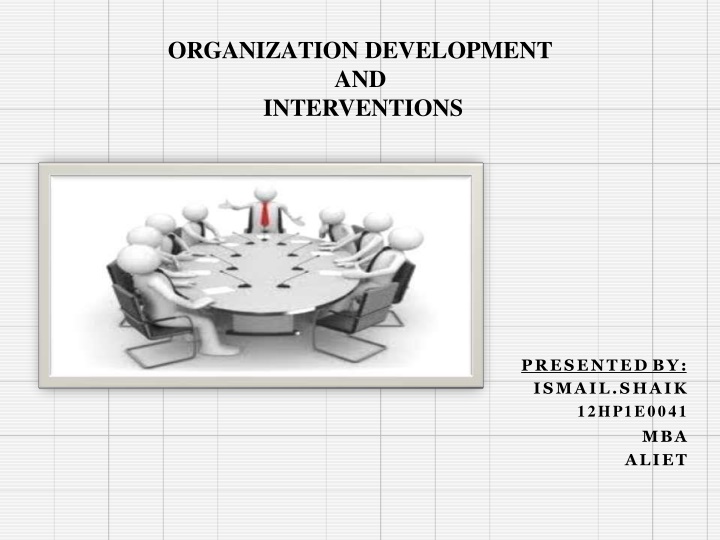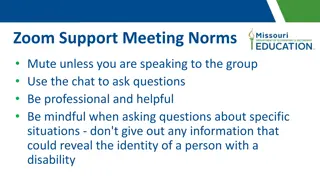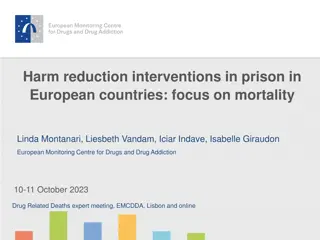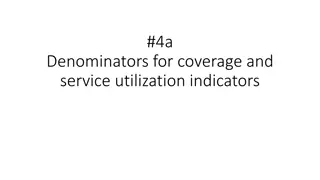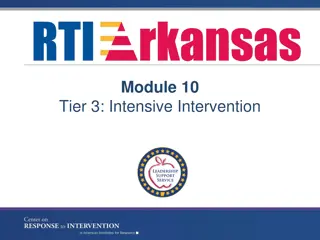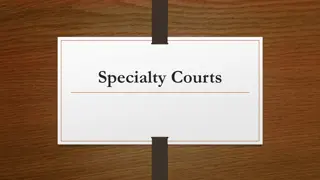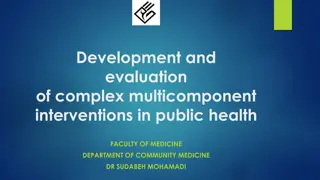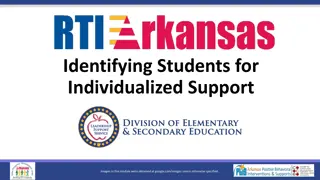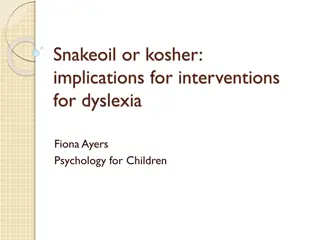Organization Development and Interventions Overview
Organization Development (OD) is a planned effort to enhance an organization's relevance and viability. It involves the systematic use of scientific and technical knowledge to meet specific objectives. OD focuses on understanding and managing organizational change by altering beliefs, attitudes, and values within an organization. Various definitions highlight OD as a strategic response to change aimed at enhancing organizational effectiveness through improved structures, processes, and strategies. The objectives of OD include fostering interpersonal trust, increasing employee satisfaction and commitment, addressing problems proactively, managing conflicts effectively, promoting cooperation, and enhancing problem-solving capabilities within the organization.
Uploaded on Aug 13, 2024 | 1 Views
Download Presentation

Please find below an Image/Link to download the presentation.
The content on the website is provided AS IS for your information and personal use only. It may not be sold, licensed, or shared on other websites without obtaining consent from the author.If you encounter any issues during the download, it is possible that the publisher has removed the file from their server.
You are allowed to download the files provided on this website for personal or commercial use, subject to the condition that they are used lawfully. All files are the property of their respective owners.
The content on the website is provided AS IS for your information and personal use only. It may not be sold, licensed, or shared on other websites without obtaining consent from the author.
E N D
Presentation Transcript
ORGANIZATION DEVELOPMENT AND INTERVENTIONS PRESENTED BY: ISMAIL.SHAIK 12HP1E0041 MBA ALIET
ORGANIZATIONAL DEVELOPMENT(OD) CONTENTS: ORGANIZATIONAL DEVELOPMENT. MEANING AND DEFINITIONS OF OD. OBJECTIVES OF OD. ASSUMPTIONS AND VALUES OF OD. PROCESS OF OD. EFFECTIVENESS OF OD.
INTRODUCTION TO OD: The term organizational development was coined by Richard Beckhard in the mid-1950s.Organizational development is an acronym of two words i.e., organization anddevelopment. Organization: A social unit of people that is structured and managed to meet a need or to pursue collectivegoals. Development: The systematic use of scientific and technical knowledge to meet specific objectives orrequirements. ORGANIZATION DEVELOPMENT: Organization development (OD) is a deliberately planned effort to increase an organization's relevance and viability. Organizational development is the framework for change, and often times a manager helps to lead this change.
MEANING OFOD: Organization development is known as both a field of applied behavioral science focused on understanding and managing organizational change and as a field of scientific study andinquiry. OD is a systemic learning and development strategy intended to change the basics of beliefs, attitudes, and relevance of values and structure of the current organization to better absorb disruptive technologies, market opportunities, and ensuing challenges and chaos. DEFINITIONS OFOD: According to Middlemist and Hitt define organizational development is a systematic means for planned change that involves the entire organization and is intended to increase organizationaleffectiveness. Cummings and Huse define OD A system wide application of behavioral science knowledge to the planned organizational strategies, structure, and processes for improving an organization s effectiveness. development and reinforcement of
Bennis. W define Organizational development is a response to change, a complex educational strategy intended to change beliefs, attitudes, values, and structures of organizations so that they can better adapt to new technologies, markets, and challenges, and the dizzying rate of changeitself. Cummings and Worley define "Organization development is a system- wide application of behavioral science knowledge to the planned development and reinforcement of organizational strategies, structures, and processes for improving an organization'seffectiveness."
OBJECTIVES OFOD: According to somil aseeja, the objective of odis: To increase the level of inter-personal trust among employees. To increase employee's level of satisfaction and commitment. To confront problems instead of neglectingthem. To effectively manage conflict. To increase cooperation among the employees. To increase the organization problem solving. To put in place process that will help improve the ongoing operation of the organization on a continuousbasis.
ASSUMPTIONS AND VALUES OFOD: ASSUMTIONS Individuals: V ALUES Individuals: People want to grow and mature. Employees have much to offer (e.g. creativity and energy) that is not being used at work . Most employees opportunity to desire, seek empowerment). OD aims to overcome obstacles to the natural human grow, enabling contribute more to the organization. OD stresses communication, Treating employees with genuine dignity and respect is emphasized. tendency employees to to desire the open contribute and (they appreciate Groups: Groups: Hiding accepted by the group diminishes individual willingness problems constructively Acceptance, collaboration involvement lead to expressions of feelings and perceptions. feelings or not being Groups and teams are critical to organizational success and individual need satisfaction. Groups have powerful influences on individual behaviour. The complex roles to be played in groups require skilldevelopment. to solve and
Organization: Organization: Excessive rules are detrimental Conflict can be functional if properly Individual and organizational goals can be compatible . controls, policies and The linked, Effectiveness, change should start at the top and gradually be introduced through the rest of theorganization. way groups are their influences channeled In most organizations, the level of interpersonal support, cooperation is lower than desirable and necessary The group links the top and bottom of the organization trust and
PROCESS OFOD: Organization Development (OD) is a planned approach to improve employee and organizational effectiveness by conscious interventions in those processes and structures that have an immediate bearing on the human aspect of the organization. Anormal OD process can be phased in followingmanner: . Problem Identification Data Collection Diagnosis Planning and Implementation Evaluation and Feedback
Problem identification: The first step in OD process involves understanding and identification of the existing and potential problems in the organization. The awareness of the problem includes knowledge of the possible organizational problems of growth, human satisfaction, the usage of human resource and organizational effectiveness. Data Collection: Having understood the exact problem in this phase, the relevant data is collected through personal interviews, observations andquestionnaires. Diagnosis: OD efforts begin with diagnosis of the current situation. Usually, it is not limited to a single problem. Rather a number of factors like assumption, available resources and management practice are taken account in this phase. There are four steps in organizationaldiagnosis: Structural analysis: Determines how the different parts of the organization are functioning in terms of laid down goals. attitudes, into
Process analysis: Process implies the manner in which events take place in a sequence. It refers to pattern of decision making, communication, group dynamics and conflict management patterns within organization to help in the process of attainment of organizationalgoals. Function analysis: This includes strategic variables, results, achievements and finaloutcomes. Domain analysis: Domain refers to the area of the organization for organizational diagnosis. Planning and implementation: After diagnosing the problem, the next phase of OD, with the OD interventions, involves the planning and implementation part of the change process. Evaluation and feedback: Any OD activity is incomplete without proper feedback. Feedback is a process of relaying evaluations to the client group by means of specific report or interaction performance variables,
EFFECTIVENESS OFOD: Humanistic values underlie OD. Margulies and Raia articulated the humanistic values of OD asfollows: Providing opportunities for people to function as human beings rather than as resources in the productiveprocess. Providing opportunities for each organization member, as well as for the organization itself, to develop to his fullpotential. Seeking to increase the effectiveness of the organization in terms of all of its goals. Attempting to create an environment in which it is possible to find exciting and challenging work. Providing opportunities for people in organizations to influence the way in which they relate to work, the organization, and theenvironment. Treating each human being as a person with a complex set of needs, all of which are important in his or her work andlife.
ORGANIZATION INTERVENTIONS(OI) CONTENTS INTRODUCTION TOOI. MEANING OFOI. ASSUMPTIONS OFOI. FACTORS THAT HELPS CHANGEAGENT. EXAMPLES OFINTERVENTIONS.
INTRODUCTION TO OI: They may be introduced by a change agent as part of an improvement program, or they may be used by the client following a program to check on the state of the organization's health, or to effect necessary changes in its own behavior. "Structured activities" mean such diverse procedures as experiential exercises, questionnaires, attitude surveys, discussions, and even lunchtime meetings between the change agent and a member of the client organization. interviews, relevant group Every action that influences an organization's improvement program in a change agent-client system relationship can be said to be anintervention. There are many possible intervention strategies from which tochoose.
MEANING OFOI: "Interventions" are principal learning processes in the "action" stage of organization development. Interventions individually or in combination by the members of a client system to improve their social or task performance. Interventions range from those designed to improve the effectiveness of individuals through those designed to deal with teams and groups, intergroup relations, and the totalorganization. There are interventions that focus on task issues (what people do), and those that focus on process issues (how people go about doing it). Finally, interventions may be roughly classified according to which change mechanism they tend to emphasize: for example, feedback, awareness of changing cultural norms, interaction and communication, conflict, and education through either new knowledge or skillpractice. are structured activities used
ASSUMPTIONS OFOI: Several assumptions about the nature and functioning of organizations are made in the choice of a particular strategy. Beckhard lists six such assumptions: The basic building blocks of an organization are groups (teams). Therefore, the basic units of change are groups, notindividuals. An always relevant change goal is the reduction of inappropriate competition between parts of the organization and the development of a more collaborative condition. Decision making in a healthy organization is located where the information sources are, rather than in a particular role or level ofhierarchy. Organizations, subunits of organizations, and individuals continuously manage their affairs against goals. Controls are interim measurements, not the basis of managerial strategy. One goal of a healthy organization is to develop generally open communication, mutual trust, and confidence between and acrosslevels. People support what they help create. People affected by a change must be allowed active participation and a sense of ownership in the planning and conduct of the change
FACTORS THAT HELP CHANGEAGENT: Some of the things which will help himare: A real need in the client system tochange. Genuine support frommanagement. Setting a personal example: listening, supportingbehavior. A sound background in the behavioralsciences. A working knowledge of systemstheory. A belief in man as a rational, self-educating being fully capable of learning better ways to do things.
EXAMPLES OFINTERVENTIONS: A few examples of interventionsinclude Team Building. Coaching. Large Group Interventions. Mentoring. PerformanceAppraisal. Downsizing. TQMAnd Leadership Development.
References: www.wikipedia.com www.businessdictionary.com www.boundless.com www.msu.edu.com
